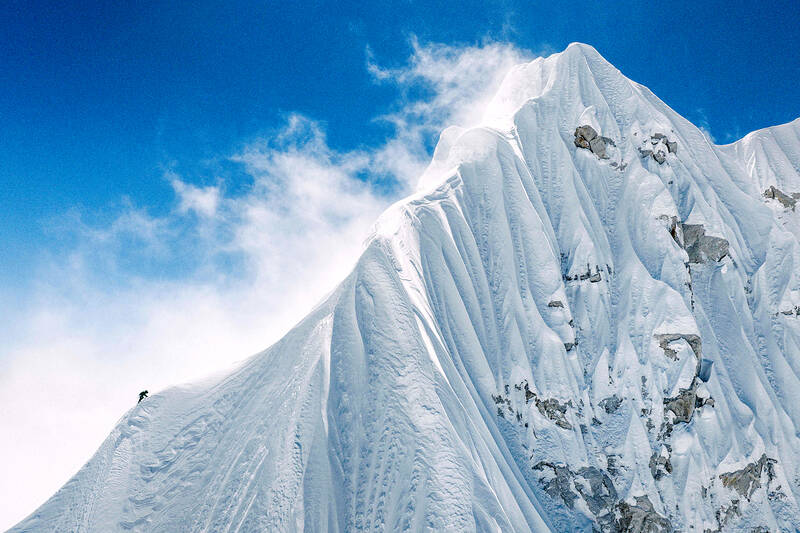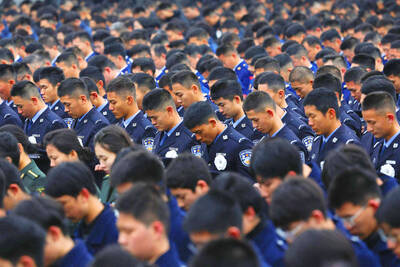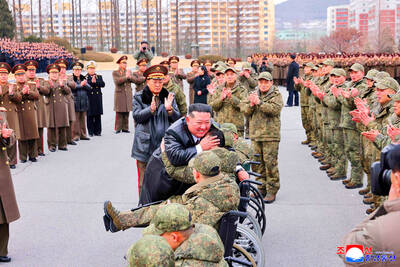Nepal’s mountains, including Everest, have long drawn climbers from across the world, but a growing community is exploring hidden summits promising solitude and the chance to be first to the top.
The Himalayan nation is home to eight of the world’s 10-highest peaks and welcomes hundreds of climbers every year, making mountaineering a lucrative business.
While commercial expeditions dominate on Everest and other 8,000m giants, a new generation of adventurers is looking sideways rather than upward — toward the countless 6,000m and 7,000m summits studding Nepal.

Photo: Thibaut Marot / AFP
The country has 462 peaks open for climbing and about 100 have never been summited.
“If you are only interested in the height of the peak then there are limited mountains to climb,” French alpinist and veteran expedition leader Paulo Grobel said.
“But if you open your interest to 7,900 meters, there is a lot of potential. If you go to 6,900 meters, you have many more peaks waiting,” he added.
This autumn Nepal has issued 1,323 climbing permits.
While most climbers are part of large commercial expeditions on popular peaks, small, independent teams are dispersed across remote and lesser-known mountains.
Many of these expeditions, including French, Japanese and Swiss teams, are tackling summits in true alpine style: minimal support, no supplementary oxygen, no fixed ropes and carrying all their own gear.
The concept is not new, but it is rapidly gaining momentum.
“It’s a huge challenge,” said French mountaineering star Benjamin Vedrines, 33, back from the first ascent of the 7,468m Jannu East with another French climber, Nicolas Jean.
“For me, it is very important. Alpine style is completely different in terms of skills, in terms of passion. The adventure is way bigger,” he said.
Vedrines believes there are huge possibilities for alpine climbs on Nepali mountains outside the highest peaks.
“They’re just lower than 8,000 meters,” he said. “Maybe society values them less, but they’re underrated. There’s so much left to explore.”
The shift comes as questions about sustainability, overcrowding and commercialization reshape mountaineering.
“With more crowds on the 8000’ers it is actually a beautiful development,” said Billi Bierling, who runs the Himalayan Database recording expedition data.
“That young, technically able alpinists are looking at other, more interesting peaks,” he said.
“Hopefully, it will also be safe because that’s the next thing,” he said.
Many of Nepal’s mid-range peaks remain logistically out of reach — not because they are too difficult, but because they are too remote.
“In Nepal, what is challenging is access,” said Nepali climber and guide Vinayak Malla, whose team has been nominated for the prestigious Piolets d’Or award for the first ascent of the 6,450m Patrasi Peak last year.
“It is expensive to travel and then you will have to trek to areas where hotels don’t exist much,” he added. “Rescue is difficult.”
On the plus side, smaller expeditions also mean climbers are spread across a wider area, bringing tourism income to valleys that have long remained outside mainstream trekking routes.
In August, Nepal waived climbing fees for 97 mountains to promote lesser-known peaks.
“We are seeing more interest in mountains below 8,000 meters,” said Himal Gautam, chief of the mountaineering section at Nepal’s tourism department.
“Gradually, we’re promoting new regions, so that as interest increases, the infrastructure and manpower needed to support them can develop,” he said.
Grobel said it is another part of “Nepal’s climbing story.”
“If you are interested in the climbing experience, you need to go to the other peaks,” he said.
“The possibilities are endless,” he said.

China yesterday held a low-key memorial ceremony for the 1937 Nanjing Massacre, with Chinese President Xi Jinping (習近平) not attending, despite a diplomatic crisis between Beijing and Tokyo over Taiwan. Beijing has raged at Tokyo since Japanese Prime Minister Sanae Takaichi last month said that a hypothetical Chinese attack on Taiwan could trigger a military response from Japan. China and Japan have long sparred over their painful history. China consistently reminds its people of the 1937 Nanjing Massacre, in which it says Japanese troops killed 300,000 people in what was then its capital. A post-World War II Allied tribunal put the death toll

‘NO AMNESTY’: Tens of thousands of people joined the rally against a bill that would slash the former president’s prison term; President Lula has said he would veto the bill Tens of thousands of Brazilians on Sunday demonstrated against a bill that advanced in Congress this week that would reduce the time former president Jair Bolsonaro spends behind bars following his sentence of more than 27 years for attempting a coup. Protests took place in the capital, Brasilia, and in other major cities across the nation, including Sao Paulo, Florianopolis, Salvador and Recife. On Copacabana’s boardwalk in Rio de Janeiro, crowds composed of left-wing voters chanted “No amnesty” and “Out with Hugo Motta,” a reference to the speaker of the lower house, which approved the bill on Wednesday last week. It is

FALLEN: The nine soldiers who were killed while carrying out combat and engineering tasks in Russia were given the title of Hero of the Democratic People’s Republic of Korea North Korean leader Kim Jong-un attended a welcoming ceremony for an army engineering unit that had returned home after carrying out duties in Russia, North Korean state media KCNA reported on Saturday. In a speech carried by KCNA, Kim praised officers and soldiers of the 528th Regiment of Engineers of the Korean People’s Army (KPA) for “heroic” conduct and “mass heroism” in fulfilling orders issued by the ruling Workers’ Party of Korea during a 120-day overseas deployment. Video footage released by North Korea showed uniformed soldiers disembarking from an aircraft, Kim hugging a soldier seated in a wheelchair, and soldiers and officials

Cozy knits, sparkly bobbles and Santa hats were all the canine rage on Sunday, as hundreds of sausage dogs and their owners converged on central London for an annual parade and get-together. The dachshunds’ gathering in London’s Hyde Park came after a previous “Sausage Walk” planned for Halloween had to be postponed, because it had become so popular organizers needed to apply for an events licence. “It was going to be too much fun so they canceled it,” laughed Nicky Bailey, the owner of three sausage dogs: Una and her two 19-week-old puppies Ember and Finnegan, wearing matching red coats and silver